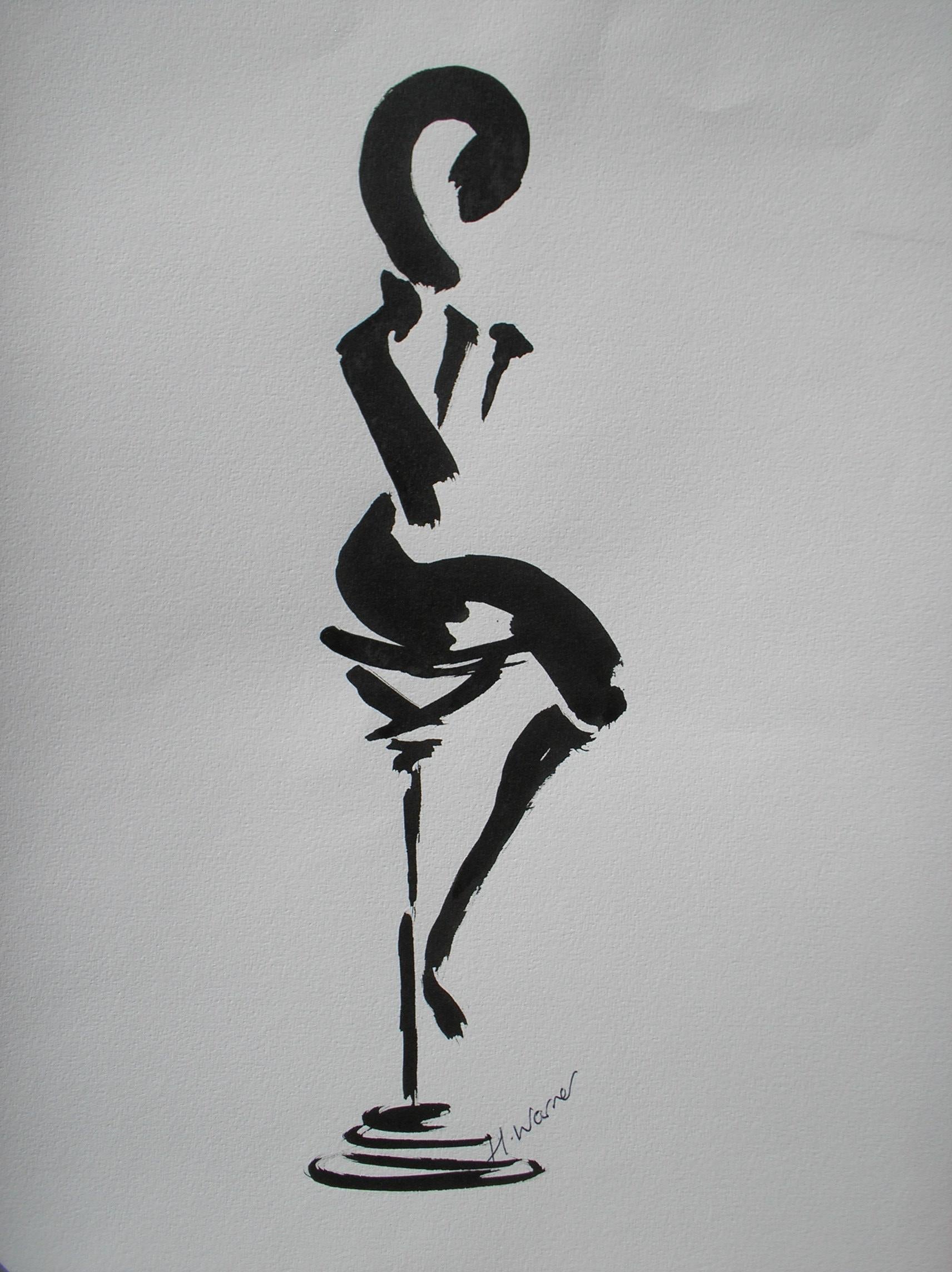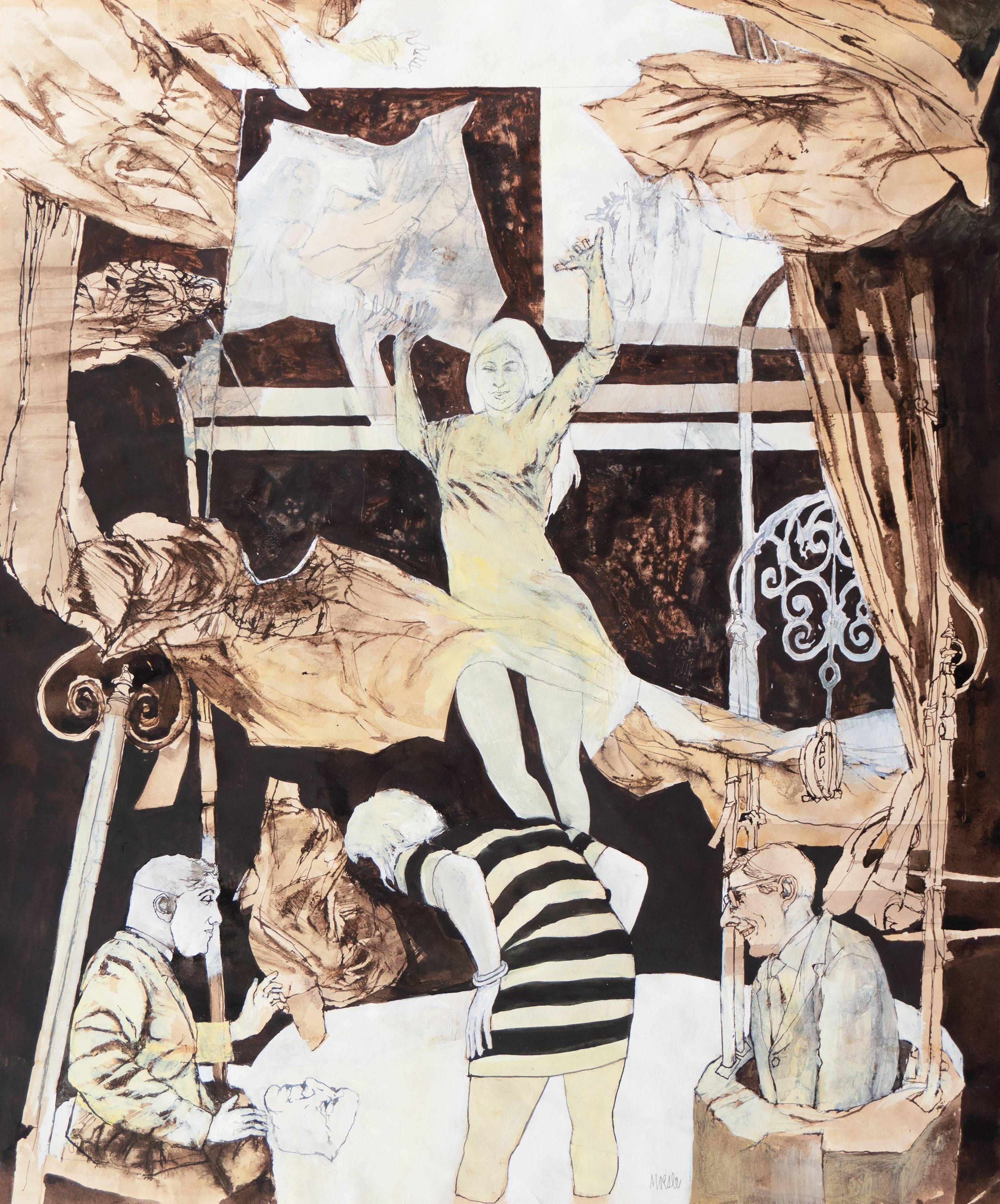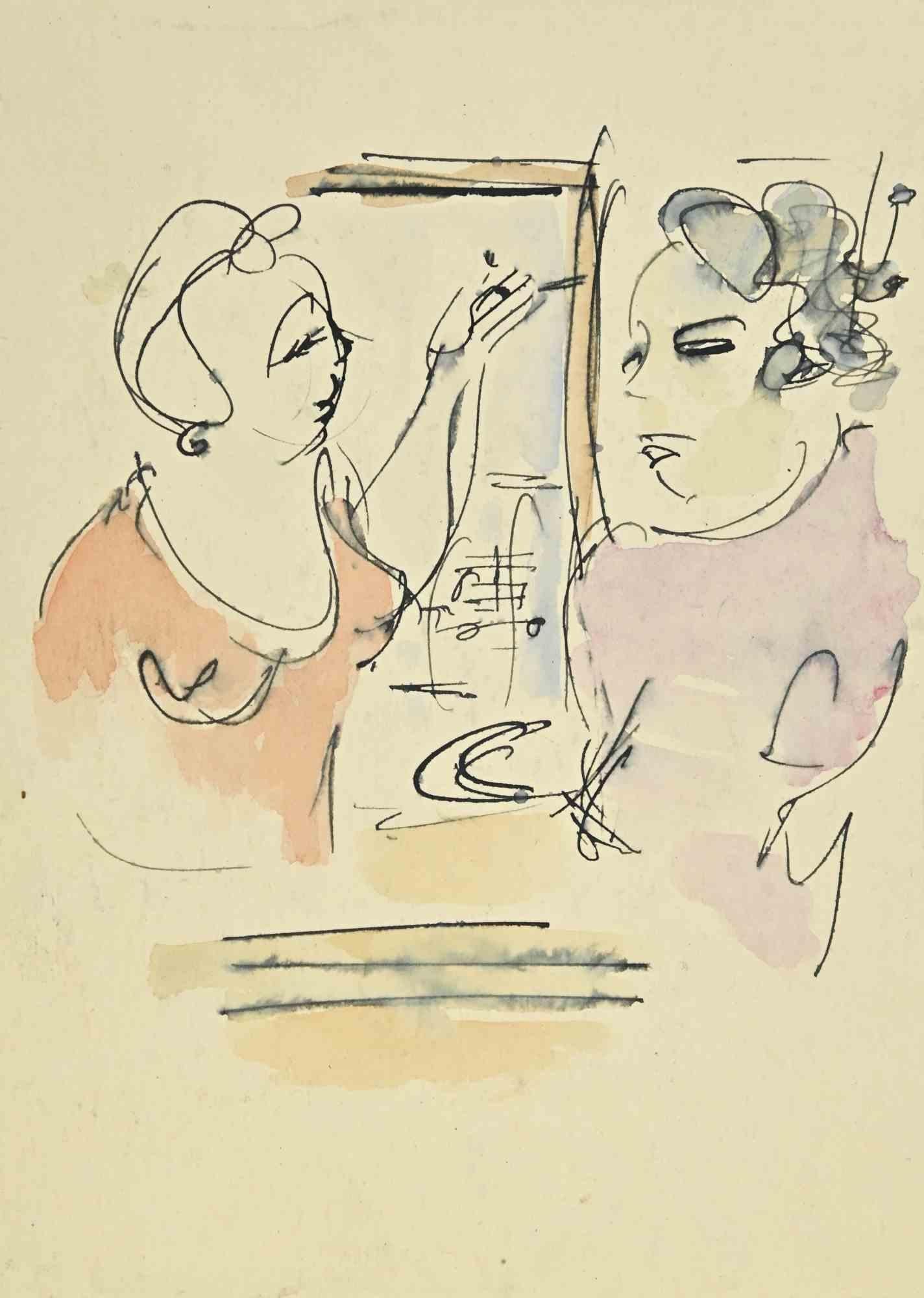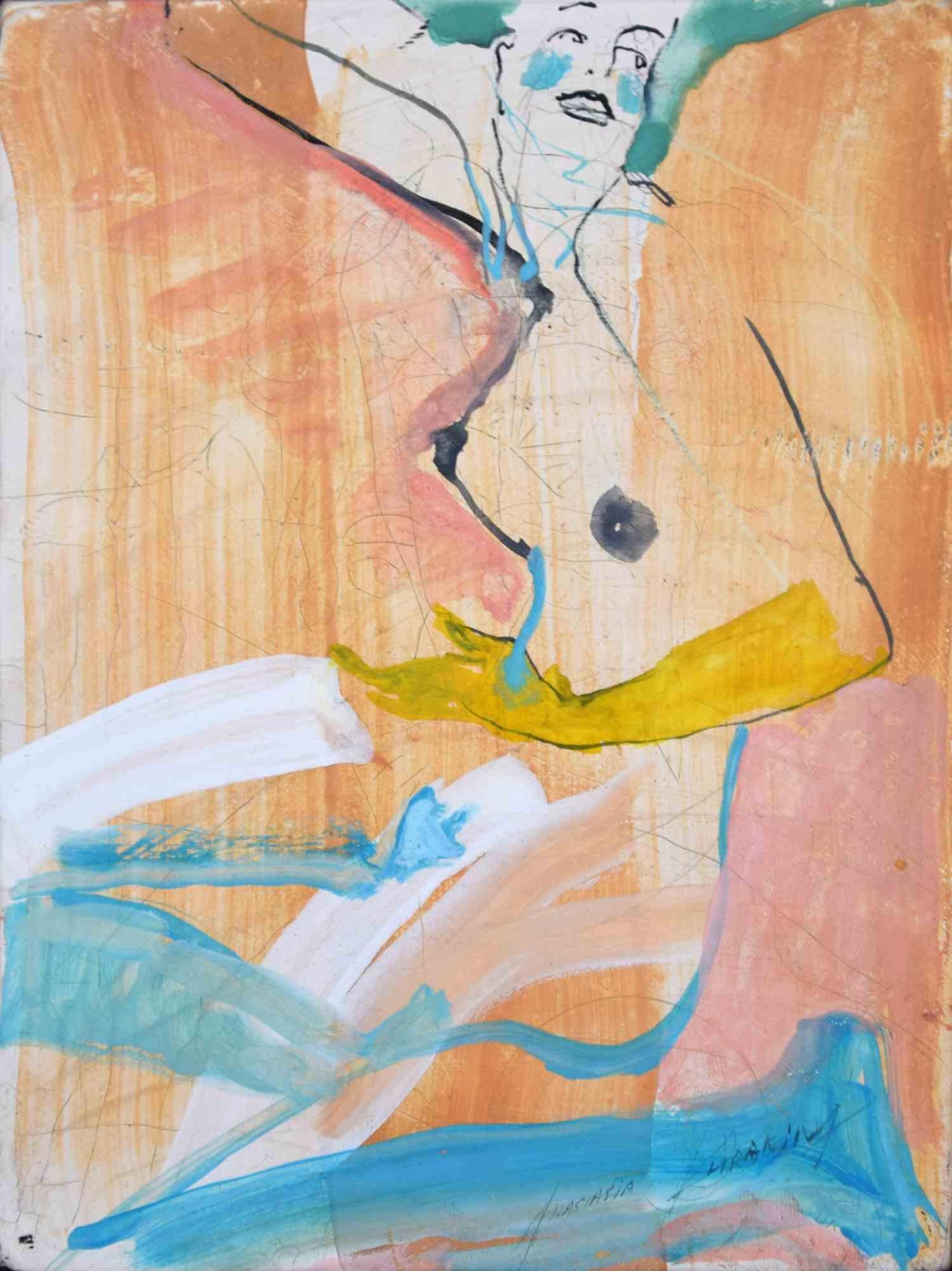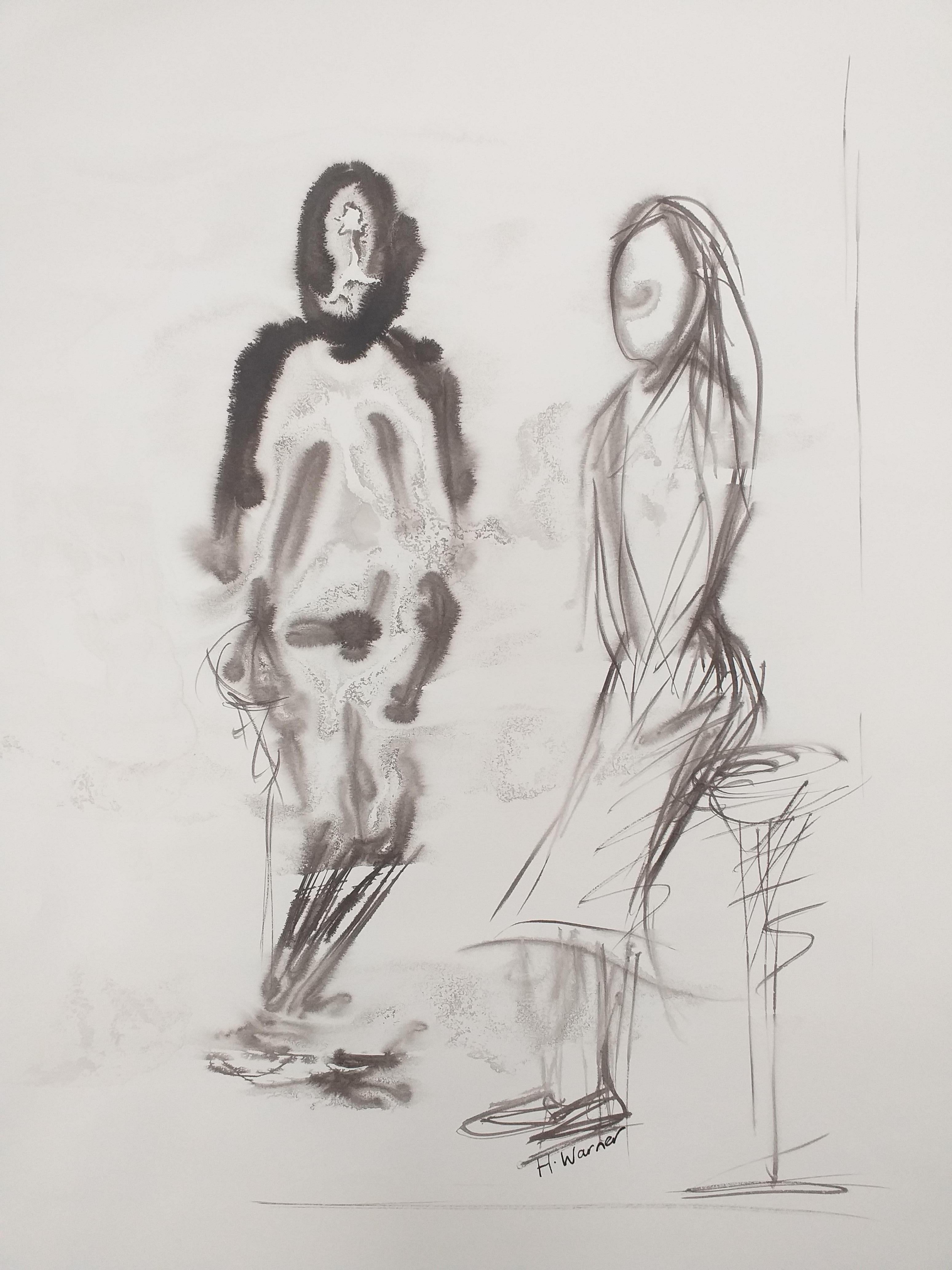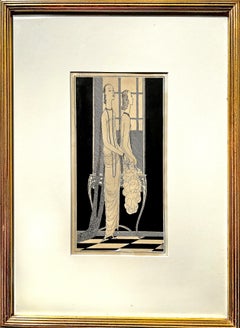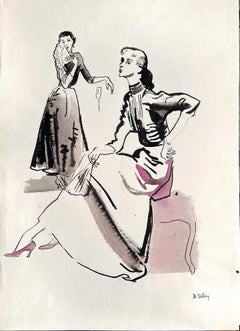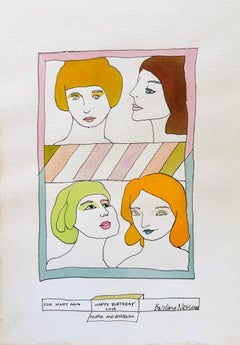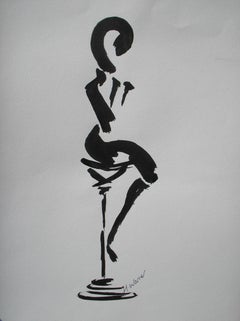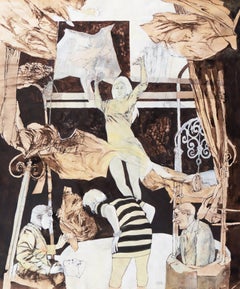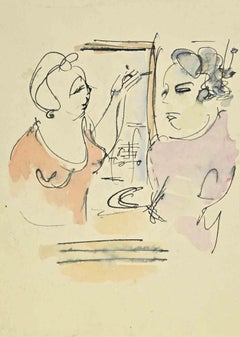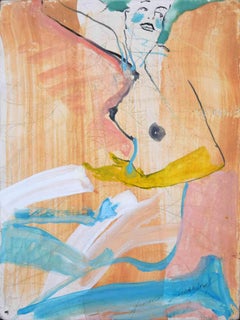Items Similar to Female Critic - Female Connosieurs - Scottish Female Artist Illustrator
Want more images or videos?
Request additional images or videos from the seller
1 of 14
Helen Paxton BrownFemale Critic - Female Connosieurs - Scottish Female Artist Illustrator1915 - 1925
1915 - 1925
$12,500
£9,579.74
€11,010.22
CA$17,556.86
A$19,649.37
CHF 10,285.74
MX$238,704.23
NOK 130,602.80
SEK 123,246.05
DKK 82,155.65
About the Item
Two young Scottish women wear smart business jackets and fashionable tartan skirts. They are depicted as discerning Art Connoisseurs evaluating a small bronze dancer. The Artist Helen Paxton Brown incorporates them at the top of a composition of stacked silhouetted graphic arts objects, such as a sword, a wooden painter's palette with brushes, a lithographer's press and roller, bagpipes, a pen and an inkwell, a fruit-on-the-vine, and a nude male. All elements of the drawing are meticulously rendered in precise detail. The small bronze dancer, for example, is only one inch tall but is perfect in its proportion and line of action.
The work is masterfully rendered in minute detail using the finest thin black lines, showcasing extremely small and precise detail. Her composition is quite complex as well and demonstrates the remarkable technical skill of the artist.
We are unsure of the date, but the subjects' short dresses may suggest it is closer to mid-century than the turn-of-the-century. Yet all other aspects of the work suggest it is from 1915 - 1925. Despite the subject's short skirts, one could make the case that the work was executed closer to the turn of the 20th century since that was when both Jessie M. King and her friend Helen Paxton Brown were in their prime—the look and feel of the paper point to this work being around 100 years old. Clearly, the work should be celebrated for its artistic skill and for featuring women as critics, not men.
If it were done from 1915- 1925 .. that would make it more significant.
Additionally, it came from the collection of Jessie M. King who died in 1949.
Titled " The Critic," I DEDICATE THIS DRAWING TO E. A. TAYLOR, Lower center - Ernest Archibald Taylor, better known as E A Taylor, was a Scottish artist, an oil painter, watercolourist and etcher, and a designer of furniture, interiors and stained glass. He was also the husband of famed Scottish Female Illustrator Jessie M. King. . Unsigned. Framed under glass 21.25 x 15.25 . The work came from the collection of Jessie M. King who died in 1949. Pen and ink on paper with silver metallic paint highlights
From: Wikipedia
Helen Paxton Brown (1876 – 20 March 1956) also known as "Nell", was an artist associated with the Glasgow Girls. Born in Hillhead, Glasgow to a Scottish father and English mother[1] and she spent most of her life in Glasgow. Best known for her painting and embroidering she also worked in a range of mediums such as leather, book binding and also painted china.
Education and career
Brown studied at Glasgow School of Art (GSA) from 1894 to 1901 under directorship of the progressive Fra. H Newbery.[2] She was a student of Ann Macbeth at GSA and then went on to teach art embroidery to teachers at GSA from 1904 to 1907 (embroidery being an important part of GSA craft at that time) and then book binding from 1911 to 1913. It was whilst studying at GSA that she met her good friend Jessie M. King who she shared a studio flat with at 101 St Vincent Street, Glasgow from around 1898 until 1907 when King got married. The women's friendship was longlasting and strong despite the different trajectories of their careers. King attracted international acclaim but despite some early notice Brown had less success. The two women often modelled for each other and were inseparable companions during the years they lived together.[3]
After GSA Brown went to Paris to attend sketching classes and was an admirer of the free style of French Impressionists and would continue to visit Paris throughout her career. Her work mainly captures people out enjoying life, capturing atmosphere and café scenes (reflecting her interest in fashion and clothes), but she also painted landscapes and flowers too.
She is quoted as saying that she chose embroidery because she enjoyed "playing with colour" but also because it would sell as "art for art's sake is the road to starvation nowadays".[4] She was reportedly vivacious and noted for her witty wisecracks[5]
In the 1900s Patrick Geddes and Fra Newberry led a number of Scottish masques and pageants relating to Pan-Celtic events involving a range of Arts and Crafts designers from Edinburgh and Glasgow. Helen Paxton Brown was involved in the "historical" pageant production at the University of Glasgow.[6]
Exhibitions and commissions
Glasgow School of Art
Brown joined "The Glasgow Society of Artists" (started by physician Alexander Frew, husband of painter Bessie MacNicol) which women could join unlike the all-male Glasgow Art Club. Although short-lived, the society provided an alternative for those painters dissatisfied with the Glasgow establishment.[3] She was also a member of the Glasgow Society of Lady Artists from 1905 and became an honorary member in 1948 where her work could often be found as well as at the Glasgow Art Institute.
From 1920s Brown started using more bright colours and bolder designs in both her painting and embroidery. This development was shown in a joint exhibition with Jessie M. King at the Glasgow Society of Lady Artists’ exhibition in April 1931 called "Spring in Three Room"[7] which not only showed their paintings but saw them taking over three rooms which were decorated in bright yellows and creams showing different home decoration, in stark contrast to the then contemporary style of dark furniture. Jessie M. King and Paxton Brown exhibited their work on several occasions together.
In 1925 she received a commission from Mount Blow, Dalmuir to paint 12 mural panels of nursery rhymes, through the Glasgow Corporation Welfare Scheme.[8]
- Creator:Helen Paxton Brown (1876 - 1956, Scottish)
- Creation Year:1915 - 1925
- Dimensions:Height: 14 in (35.56 cm)Width: 8.13 in (20.66 cm)
- Medium:
- Period:
- Condition:some yellow to the paper and a few scatters spots of foxing in the lower quadrant - commensurate with age, Otherwise presents quite well.
- Gallery Location:Miami, FL
- Reference Number:1stDibs: LU385316370442
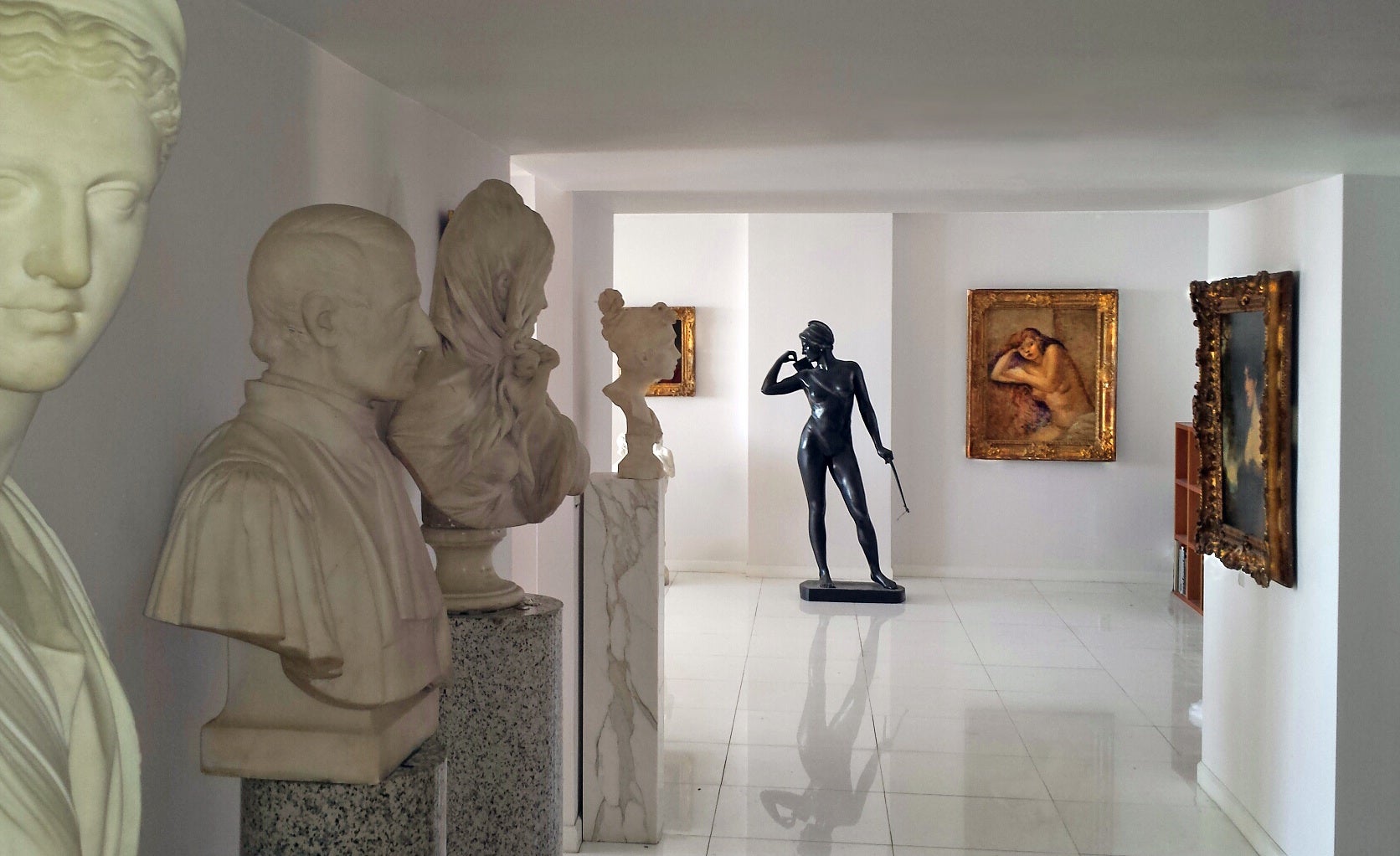
About the Seller
4.9
Gold Seller
Premium sellers maintaining a 4.3+ rating and 24-hour response times
Established in 2005
1stDibs seller since 2016
115 sales on 1stDibs
Typical response time: 1 hour
- ShippingRetrieving quote...Shipping from: Miami, FL
- Return Policy
Authenticity Guarantee
In the unlikely event there’s an issue with an item’s authenticity, contact us within 1 year for a full refund. DetailsMoney-Back Guarantee
If your item is not as described, is damaged in transit, or does not arrive, contact us within 7 days for a full refund. Details24-Hour Cancellation
You have a 24-hour grace period in which to reconsider your purchase, with no questions asked.Vetted Professional Sellers
Our world-class sellers must adhere to strict standards for service and quality, maintaining the integrity of our listings.Price-Match Guarantee
If you find that a seller listed the same item for a lower price elsewhere, we’ll match it.Trusted Global Delivery
Our best-in-class carrier network provides specialized shipping options worldwide, including custom delivery.More From This Seller
View AllArt Deco Woman before a Mirror - Vogue Magazine Artist
Located in Miami, FL
Fabled Vogue Magazine Cover Artist Eduardo Garcia Benito depicts a perfectly posed long-neck flapper with her reflection in a mirror, Her extrav...
Category
1920s Figurative Drawings and Watercolors
Materials
Paper, Ink, Gouache
Art Deco Woman before a Mirror - Vogue Magazine Artist
Located in Miami, FL
Fabled Vogue Magazine Cover Artist Eduardo Garcia Benito depicts a perfectly posed long-neck flapper with her reflection in a mirror, Her extrav...
Category
1920s Art Deco Figurative Drawings and Watercolors
Materials
Paper, Ink
Mid- Century Fashion Illustration - Neiman Marcus ?
By Marjorie Ullberg
Located in Miami, FL
1950's elegant fashion models pose depicted for a designer clothing line for a major San Francisco department store - Perhaps Neiman Marcus. Estate ...
Category
1950s Modern Figurative Drawings and Watercolors
Materials
Watercolor, Pencil
Happy Birthday Drawing: Love Barbara Nessim and Gloria Steinem
By Barbara Nessim
Located in Miami, FL
In the late 1960s, Barbara Nessim and Gloria Steinem were roommates. This stylised and colorful illustration appears to be a highly personalized birthday card to their friend Mary A...
Category
1960s American Modern Portrait Drawings and Watercolors
Materials
Ink, Watercolor, Archival Paper
Fashion Model Illustration Perhaps for Vogue Magazine
By Ruth Sigrid Grafstrom
Located in Miami, FL
This high-fashion illustration was most likely created between 1938 and 1940 for an inside editorial in a major newspaper, such as Vogue or McCall's. It showcases Ruth Grafstrom's d...
Category
1930s American Modern Figurative Drawings and Watercolors
Materials
Paper, Ink, Watercolor
Introspective Woman / Actress on Movie Set. Mid Century Art, Female Illustrator
By Lorraine Fox
Located in Miami, FL
Lorraine Fox was an American illustrator and commercial artist who illustrated magazines, book covers, and advertisements. Among the magazines, she illustrated for were Woman's Day, ...
Category
1960s Post-Impressionist Figurative Paintings
Materials
Watercolor, Gouache, Board, Pencil
You May Also Like
British Contemporary Art by Helen Warner - She's There
Located in Paris, IDF
Ink on paper
Helen Warner is a British artist born in 1978 who lives and works in Southampton, UK. She studied Art, Sport Studies and Human Biology at co...
Category
2010s Contemporary Figurative Drawings and Watercolors
Materials
Ink, Paper
'Dynamic Figurative', California Post-Impressionist, Ruskin School of Art
By Robert Moesle
Located in Santa Cruz, CA
Signed lower right "Moesle" and painted circa 1975.
Gouache and watercolor figurative showing numerous figures in dynamic interaction.
Born in 1932, Robert Moesle studied painting ...
Category
1970s Figurative Drawings and Watercolors
Materials
Paper, India Ink, Watercolor, Gouache
Women - Drawing - Mid-20th Century
Located in Roma, IT
Women is a drawing realized in the Mid-20th Century.
Ink and watercolor on Paper.
Good conditions with slight foxing.
The artwork is realized through deft expressive strokes.
Category
Mid-20th Century Modern Figurative Drawings and Watercolors
Materials
Ink, Watercolor
A Woman - Drawing by Anastasia Kurakina - 2010s
By Anastasia Kurakina
Located in Roma, IT
A woman is a contemporary artwork, realized in 2018 by the emerging artist Anastasia Kurakina.
Mixed colored watercolor and china ink drawing on panel.
Good conditions
Hand signed...
Category
2010s Contemporary Drawings and Watercolor Paintings
Materials
Watercolor
Women
By Carlotta Costantini
Located in Roma, IT
Women is an original artwork by Carlotta Costantini realized with watercolor and china ink on ivory paper, signed on lower central margin. Perfect conditions.
Passepartout included ...
Category
20th Century Modern Figurative Prints
Materials
Ink, Watercolor
British Contemporary Art by Helen Warner - Lady and Man
Located in Paris, IDF
Ink on paper
Helen Warner is a British artist born in 1978 who lives and works in Southampton, UK. She studied Art, Sport Studies and Human Biology at college and being a passionate...
Category
2010s Contemporary Figurative Drawings and Watercolors
Materials
Ink, Paper
More Ways To Browse
Female Artists Painting
Artist Paint Brushes Used
Scottish Artists
Antique Brown Paint Color
Antique Drawing Room Furniture
Strong Female
Brown Line Drawing
E H Artist
1920s French Drawing
Antique Paper Press
Helen Brown
Antique Murals
Line Drawing Of Women
Dior Dress Brown
Scottish Lithograph
Antique Artists Paint Brushes
Bronze Female Dancers
Contemporary Scottish Painters
